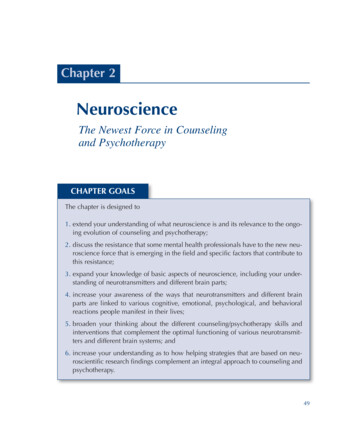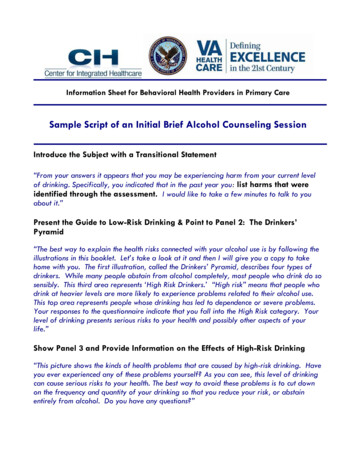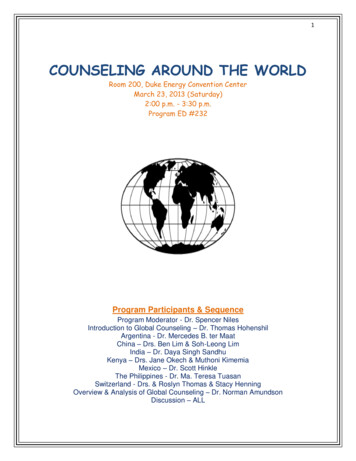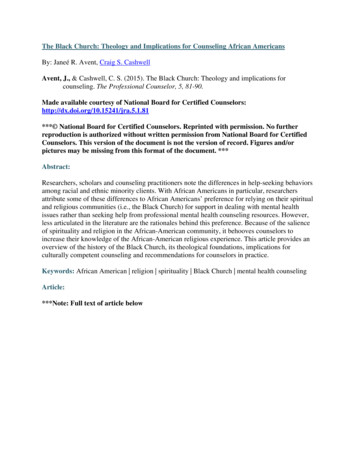
Transcription
Chapter 2NeuroscienceThe Newest Force in Counselingand PsychotherapyCHAPTER GOALSThe chapter is designed to1. extend your understanding of what neuroscience is and its relevance to the ongoing evolution of counseling and psychotherapy;2. discuss the resistance that some mental health professionals have to the new neuroscience force that is emerging in the field and specific factors that contribute tothis resistance;3. expand your knowledge of basic aspects of neuroscience, including your understanding of neurotransmitters and different brain parts;4. increase your awareness of the ways that neurotransmitters and different brainparts are linked to various cognitive, emotional, psychological, and behavioralreactions people manifest in their lives;5. broaden your thinking about the different counseling/psychotherapy skills andinterventions that complement the optimal functioning of various neurotransmitters and different brain systems; and6. increase your understanding as to how helping strategies that are based on neuroscientific research findings complement an integral approach to counseling andpsychotherapy.49
50—PART I AN INTEGRAL APPROACH TO COUNSELING AND PSYCHOTHERAPY**VIGNETTE #2Sachi is a 28-year-old, single female ofJapanese descent. She moved to the UnitedStates from Japan a year ago as a result of ajob advancement that was offered by the largecorporation where she is employed. Sachi’scareer move has resulted in advancements inher income and professional status within thecompany where she is employed. However,these career benefits have come at a cost: Sheis feeling increasingly depressed as a result ofbeing isolated from family members andfriends in Japan, and she is also experiencingelevated levels of generalized anxiety. Theincreasing anxiety Sachi is experiencing incombination with more frequent depressedmoods is leading to a circular problem, as itcontributes to Sachi’s growing concern thather work performance may suffer as a resultof these problems and possibly have a negativeThe Individual Perceptions and MeaningMaking QuadrantClients’ interior psychological processes(e.g., conscious, subconscious, unconscious)and subjective constructions of life experiencesimpact on her standing in the company. In aneffort to do something about these problems,Sachi has sought help by scheduling anappointment with a counselor in the company’s Employee Assistance Program.We will refer to Sachi’s case at differentpoints in this chapter to highlight various concepts associated with neuroscience and itsrelevance to counseling and therapy theoriesand practices. A description of the four quadrants that compose the integral theory is presented as a resource below. This resource isincluded at the beginning of the chapter tohelp you acquire a deeper understanding of theintegral approach to counseling and psychotherapy that is discussed throughout this book.** AN INTEGRAL APPROACHTO COUNSELING ANDPSYCHOTHERAPYThe Behavioral/Physical/Neurological QuadrantClients’ behaviors and physical/biological/neurological factors that are of relevance tocounseling and therapy practices and outcomesThe Cultural Community QuadrantThe Societal/Professional QuadrantCultural and community factors as they impactclients’ mental health and the process andoutcomes of counseling and therapySocietal and professional factors as they impactclients’ mental health as well as counseling andtherapy practices and outcomes**INTRODUCTIONMental health practitioners are becomingincreasingly aware of the neuroscientific revolution that is unfolding in the fields of counseling,education, psychiatry, psychology, and socialwork. Although there is growing awareness ofthis exciting new force in the mental health professions, many practitioners lack the training thatwould enable them to more fully understand therelevance of neuroscience to counseling andpsychotherapy theories and practices.
Chapter 2 Neuroscience—51Various issues related to neuroscience werepresented in Chapter 1. This was done toa. provide a general overview of what neuroscience is,b. acknowledge that this field is the newestforce making a substantial impact on thework mental health practitioners do inthe field, andc. explain how this new force fits into theBehavioral/Physical/Neurological Quadrantthat complements the integral approachto counseling and therapy discussed inthis book.To build on the information presented inChapter 1, we discuss additional issues of relevance to neuroscience as a vital componentin an integral approach to counseling/therapy.Consequently, we begin this chapter by reiterating the definition of neuroscience. As definedin Chapter 1,Neuroscience is essentially the scientificstudy of the nervous system. Traditionally,neuroscience has been seen as a branch ofbiology. However, it is currently viewedas an interdisciplinary science that incorporates knowledge from many other disciplines, such as psychology, computer science, mathematics, physics, philosophy, andmedicine.As a result of the interdisciplinary natureof this field, the scope of neuroscience hasbroadened to include the study of the molecular, developmental, structural, functional,evolutionary, computational, medical, andpsychological aspects of the nervous systemin general and brain functioning in particular.The research focus and techniques used byneuroscientists have also expanded enormously, from biophysical and molecular studies of individual nerve cells to a broad rangeof new imaging techniques that are used tostudy perceptual, motor, cognitive, and psychological reactions and brain functioning.The preceding chapter also generallydescribes a number of basic neuroscienceconcepts. These include discussing what neurons, neuroplasticity, and mirror neurons areand how they impact human functioning.Those discussions remind us that the brain isessentially composed of billions of neuronsthat transmit even more electronic-chemicalsignals in the brain that affect the way peoplethink, feel, and behave (Ndabahaliye, 2002).The term neuroplasticity was also definedin Chapter 1. In describing the meaning ofthis important concept, it was pointed out thatUp until the late 1990s, professional andlaypersons alike believed that people wereborn with a given number of neurons in thebrain. It was generally accepted that, whileneurons could “die” due to brain injury,disease, and exposure to toxic chemicalsentering the brain; new neurons could notbe reproduced. This widely held beliefabout brain chemistry has been found to beirrefutably false as a result of research conducted by neuroscientists during the late1990s and early 21st century. The brain’sability to reproduce new neurons and reorganize itself by forming new neural connections throughout life is referred to asneuroplasticity (Begley, 2007).There are different ways in which researchers have noted neuroplasticity to occur. One
52—PART I AN INTEGRAL APPROACH TO COUNSELING AND PSYCHOTHERAPYway involves the manner in which existingneurons contribute to the production of newneurons to compensate for injury, disease, andexposure to toxic environmental conditions(including environmental pollutants, poverty,violence, and other forms of oppression andsocial injustice).Neuroplasticity also occurs as a result ofintraneural chemical adjustments that neurons make in response to new situations andexperiences that characterize peoples’ lives.Recent research findings have verified thatneuroplasticity is enhanced when peopleare engaged in repetitive behaviors, such asroutinely practicing a musical instrument;exposed to enriched environments, such asthe enriched environments that are created inmany preschool programs; and exposed tonew, novel, supportive, and challengingactivities, including counseling and psychotherapy (Cozolino, 2002, 2010a, 2010b).The last statement in the definition of neuroplasticity underscores the basic biological factthat counseling and therapy represent uniqueexperiences that can lead to the generation ofnew neurons and neural wiring that greatlyaffect how people think, feel, and behave. Theterm neurogenesis is closely related to the concept of neuroplasticity and refers to the generation of new neurons in the brain.While neurogenesis is most apparent ininfant and child development, researchershave described conditions that foster or inhibitneurogenesis in adult animals as well (Gould,Reeves, Graziano, & Gross, 1999; Siegel,2007). This includes studies that describepositive neurogenetic reactions that are correlated with new learning activities (Becker,2005; Gould et al., 1999), adequate sleep(Mirescu, Peters, Noiman, & Gould, 2006),and physical exercise (van Praag, Shubert,Zhao, & Gage, 2005). In short, the researcherslisted above provide evidence that explainshow and why new learning activities, adequatesleep, and regular exercise contribute to thegeneration of new neurons and/or the healthymaintenance of existing neural networks.Of particular relevance to this chapter is theunderstanding of two additional basic points.First, from a neuroscientific perspective, it isimportant to understand that the process ofcounseling and psychotherapy depends onclients’ natural biological propensity forneuroplasticity and neurogenesis. This is sobecause positive counseling and therapy outcomes result in the generation of new neuronsand neural networks that affect various changesin the brain that underlie clients’ sense ofpsychological well-being or distress.Second, the types of changes clients hopeto achieve in counseling and therapy are fostered by the neurological alterations that practitioners stimulate by using various theoretical principles, skills, and interventions thatare increasingly known to stimulate the generation and optimal release of various neurotransmitters that promote changes in clients’ neural wiring and brain functioning.Thus, to expand your knowledge of the relevance of neuroscience for counseling/therapytheories and practices, this chapter builds onthe short introduction in Chapter 1 that brieflydiscusses the role of neurotransmitters. Thisdiscussion is followed by a description of keyneurotransmitters that are generated in thebody and their role in healthy brain functioning, all of which contributes to clients’ sense ofpsychological well-being or distress.This chapter continues by presenting information that describes the role and function
Chapter 2 Neuroscience—53that different parts of the brain play in affecting the way people think, feel, and behave.We hope you find the discussion of how different counseling skills and interventions contribute to the release of various neurotransmitters and healthier brain functioning to beespecially helpful in increasing your understanding of the relevance of neuroscience tothe work practitioners do with their clients.Before continuing with these discussions, it isreadily acknowledged that the study of neuroscience and its relevance to counseling and therapytheories and practices can be daunting for manypersons in the mental health professions. Thismay, in part, be due to a person’s preconceivednotions about the complexity of neuroscience aswell as one’s unfamiliarity and lack of trainingin this area. We also recognize that many peopletend to avoid learning about subjects that theythink are too complex for their liking.With this in mind, we have made a specialeffort to describe neuroscience and its relevance to counseling and psychotherapy in waysthat we hope will both increase your understanding of some of the basics of these interrelated topics and be professionally empowering.By dedicating an entire chapter to extendingthe general discussion on neuroscience that ispresented in Chapter 1, we hope you will beexcited about the potential impact this newforce has to increase the efficacy of the mentalhealth professions in the coming years.To more fully understand the relevance ofneuroscience to counseling and psychotherapytheories and practices, it is important to explorewhy this new force continues to be a vitalmissing link in the mental health professions(Farmer, 2009). It is also important to knowwhat can be and is being done to address thegeneral omission of neuroscientific knowledge in many professional training programsand clinical practices. The following sectiondiscusses these issues in greater detail.** NEUROSCIENCE:THE MISSING LINKIN COUNSELING ANDTHERAPY THEORIESAND PRACTICESDespite acknowledging that neuroscience isslowly being infused into professional training programs as well as some counseling andtherapy practices, Farmer (2009) asserts thatit continues to be the missing link in the mental health professions. In terms of the presentdiscussion, it is important to discuss how andwhy this missing link prevents mental healthpractitioners from operating at a higher levelof efficacy and intentionality.A basic assumption that underlies the following discussion is the belief that practition ers’ interest in neuroscience will be enhancedby describing the relevance of neuroscientificresearch findings as they relate to the specificskills, interventions, and theories that counselors and therapists use in the field. In additionto increasing the efficacy of the work mentalhealth professionals do, Farmer (2009) outlines several other reasons why it is importantto address this missing link in the mentalhealth professions:1. Although the neuroscientific revolutionthat is occurring in the mental healthprofessions may not provide answers toall the challenges practitioners face intheir work, the important knowledge generated from this revolution and its relevance to mental healthcare need to beacknowledged and understood.
54—PART I AN INTEGRAL APPROACH TO COUNSELING AND PSYCHOTHERAPY2. Neuroscientific insights can be ofimmediate and direct benefit in improvingour understanding of human development and behavior as well as the typesof helping interventions that are likelyto be useful in promoting positivecounseling and psychotherapeuticoutcomes among clients in diversepopulations.3. The probability is that neuroscience willcontinue to yield significant insightsthat are relevant to counseling andtherapy for the foreseeable future.Consequently, practitioners must beready—intellectually, emotionally, andinstitutionally—to understand the developments that are unfolding in these areasand be able to implement this newknowledge in their work or run the riskof becoming increasing irrelevant andnonviable members of the mental healthcare professions in the 21st century.4. Neuroscience is enhancing our understanding of what it means to be human.The utilization of knowledge generatedfrom neuroscientific research findings toincrease the effectiveness of counselingand therapy will largely depend onwhether practitioners’ conception of mental healthcare is narrow (excluding neuroscientific knowledge and research findings)or broad (including neuroscientific knowledge and research findings).5. Neuroscience can help mental healthpractitioners more effectively dealwith the multifaceted problems clientspresent; clinical practice is becomingincreasingly difficult as practitionersencounter greater complexity of humanand societal problems and diagnoses.6. Mental health professionals will increasingly be challenged to operate in waysthat reflect a greater integration ofknowledge from diverse fields and disciplines in the future. (pp. 1–2)The integral model presented in this bookrepresents one way mental health professionalscan address the missing link described above.This can be done by increasing our professional efforts to develop and implement a morefully integrated and multidisciplinary approachto helping clients. Such an approach necessitates increasing our knowledge of neuroscienceand its relevance to counseling and therapytheories and practices (Behavioral/Physical/Neurological Quadrant considerations).Clearly, the sort of comprehensiveapproach to counseling and psychotherapythat is reflected in the integral theory presented in this book requires mental healthprofessionals to move to a new level of consciousness as they are challenged to embracea more holistic view of counseling, psychotherapy, and human development (Societal/Professional Quadrant factors). As noted inthis chapter, an important aspect of developing an integral approach to counseling andpsychotherapy necessarily includes acquiringmore knowledge about neuroscience in generaland other factors that compose the Behavioral/Physical/Neurological Quadrant.History teaches us, however, that calls forsignificant changes in any professional fieldare predictably met with resistance. Certainly,that has been and to some degree continues tobe the case in calling on mental health professionals to learn about the relevance of neuroscience for counseling and therapy theoriesand to incorporate this new knowledge intotheir professional practices.
Chapter 2 Neuroscience—55The following section discusses severalfactors that underlie such resistance. It alsooutlines new ways of thinking about neuroscience that can be helpful in minimizing themanifestation of resistance to neurosciencethat contributes to the perpetuation of thismissing link in the mental health professions.** ACKNOWLEDGINGTHE RESISTANCE TONEUROSCIENCEThe assertions put forth by Farmer (2009)and other mental health professionals (Cozolino,2002, 2010a, 2010b; Ivey, Ivey, Zalaquett, &Quirk, 2009) constitute a compelling argumentthat supports the notion that neurosciencepromises to be a force that will continue totransform the practice of counseling and psychotherapy. Despite the potential of thisscience-based perspective to revolutionize thework practitioners do in the field, there is substantial resistance to support this perspectiveby numerous persons in the mental health professions. Part of this resistance is grounded inthe perceived complexity many mental healthprofessionals hold about neuroscience andtheir lack of formal training in this area, asnoted above.Louis Cozolino (2002), a well-respectedneuroscientist who has written extensivelyabout the relevance of neuroscience to psychotherapy, identified additional factors thatcontribute to this resistance. In Cozolino’s(2010b) words, “Many mental health practitioners have a bias against neuroscience. Theydescribe it as confusing and irrelevant to theirwork. Although I agree it can be confusing, it isextremely relevant to the process of counselingand psychotherapy” (p. xvi).In addition to this viewpoint, we point to aphilosophical perspective that represents adeeper and more pervasive variable underlyingmuch of the resistance that is manifestedtoward neuroscience in the mental health professions. The philosophical perspective we arereferring to is reflected in the remnants ofdualism that continue to lead many practitioners to consciously or unconsciously dichotomize their thinking about the mind and matter(e.g., the brain). This dichotomous thinkingcontributes to much of the resistance or apathetic reactions some mental health professionals feel toward the rising neuroscientific forcein counseling, psychology, and social work.Dualistic Thinking Aboutthe Mind and the BrainThe puzzle of the relationship between themind and matter (the brain) is not only aconundrum for the ages, but continues to bemanifested in different ways among mentalhealth professionals. This historical mysteryis reflected in a philosophical perspectivereferred to as dualism.Dualism is reflected in a set of views aboutthe relationship between mind and matter (i.e.,the brain), which begins with the claim thatmental phenomena are, in some respects, nonphysical. From this perspective, the mind refers tononphysical properties that include thinking,spirit, soul, or some such equivalent (Hiley, 2001).Historically speaking, dualism is thought tohave originated at least as far back as Platoand Aristotle. These philosophers speculatedthat the mind existed as an incorporeal soulfrom which a
relevance to counseling and therapy theories and practices. A description of the four quad-rants that compose the integral theory is pre-sented as a resource below. This resource is included at the beginning of the chapter to help you acquire a deeper understanding of the integral approach to counseling and psycho-











